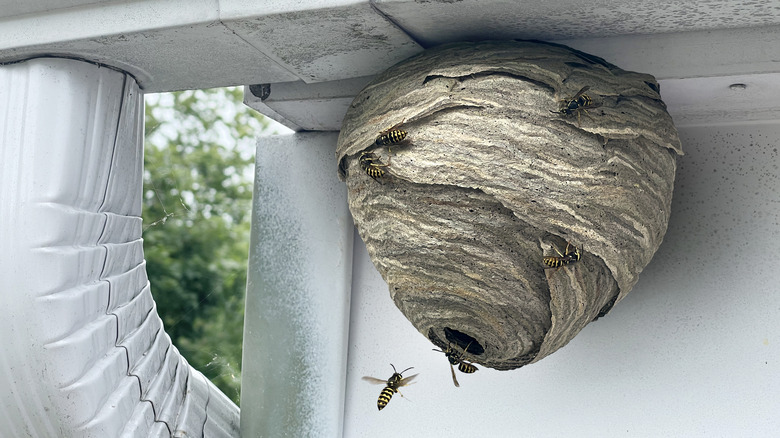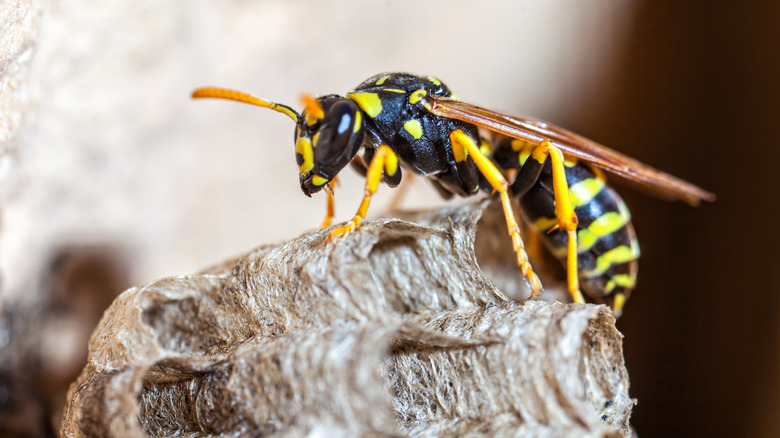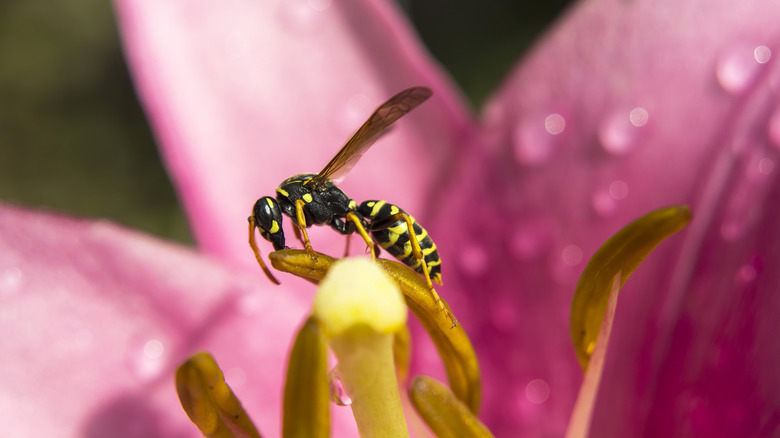Get Ahead Of Your Wasp Problem With A Spring Time Tip
While bees are often a happy sight in the garden, wasps are the opposite. Not only are their stings more painful, but they can sting you multiple times. And it seems like they just love building nests in the most inconvenient places. Rather than fretting about the safest way to remove a wasp's nest, you can prevent wasps from nesting on your property in the first place by dealing with the queens in the spring.
Wasp nests — and the wasp colonies in them — are temporary, lasting from spring to autumn and then shutting down before it gets cold (with rare exceptions). As the weather edges toward winter, most wasps die out, including the workers, drones, and the current queen. Only future queens survive to hibernate through the winter. Those who make it will emerge again in the spring to build a brand new nest, lay eggs, and then forage for food for the young. By killing a queen wasp soon after she emerges in the spring, you can get ahead of your wasp problem by preventing a new nest from being built, cutting down on the number of wasps around overall. Similarly, if you kill a queen shortly after she has built a nest, the colony will likely die since the queen is the only source of food at that time.
Identifying a queen wasp
It can be tricky to tell the difference between a queen wasp and a worker or drone. In some species, such as paper wasps, they look identical. But in general, queen wasps are much larger, around 1 ½ inches on average or up to three times the size of the workers and drones. The easiest way to identify a queen, though, is by timing. Any wasp that you see out flying in the late spring is likely to be a queen, since few other wasps are alive at that time. You can kill a queen wasp the same way that you would kill any other, such as with baits, traps, or sprays. Keep in mind that, although queen wasps are less likely to sting, they will do so when threatened and their stingers are larger and more painful than other wasps.
This method is only effective if the timing is right. By the summer, you're unlikely to get a glimpse of a queen outside of her nest, and even if you did manage to kill one, it wouldn't have much impact since the colony is already established. If the queen were to die, other females could gain the ability to lay eggs and a new queen would develop. However, getting rid of a future queen in the late fall or winter could work, after the rest of the colony has died, but before the queen has built her own nest. Wasps often hibernate under tree bark, in building cracks, in attics or sheds, or under soil.
Other limitations of this method
Killing a queen isn't a foolproof way to get rid of wasps. Sometimes there are multiple queens in a nest, especially at the start of the season. Other wasps are solitary, so they don't have queens at all — each female builds a nest of her own for her young, and killing a single female won't make much of a dent in the overall population. There are also some cons to killing queen wasps. They're beneficial for local ecosystems and for gardens, since they help pollinate plants and control other pests like flies and aphids. Getting in the way of wasps building their nests around your home could have a ripple effect on the environment.
One alternative is to deter queens from building nests on your property by keeping the space clear of trash or food sources, sealing cracks and crevices, and planting wasp-repelling plants such as geranium or wormwood. It's also important to remove any old nests to keep wasps from coming back. Fake wasp nests are a common decoy that seem to work well for some people, but there's no evidence that they're effective.


